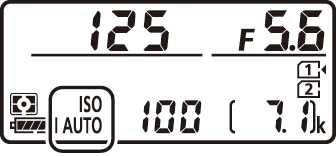Adjusting the Camera’s Sensitivity to Light (ISO Sensitivity)
ISO Sensitivity
The camera’s sensitivity to light can be adjusted according to the amount of light available. Choose from settings that range from ISO 100 and ISO 51200. Settings of from about 0.3 to 1 EV below ISO 100 and 0.3 to 2 EV above ISO 51200 are also available for special situations. The higher the ISO sensitivity, the less light needed to make an exposure, allowing higher shutter speeds or smaller apertures.
Adjusting ISO Sensitivity
Hold the S (Q) button and rotate the main command dial.
-
The selected option is displayed in the control panel and viewfinder.
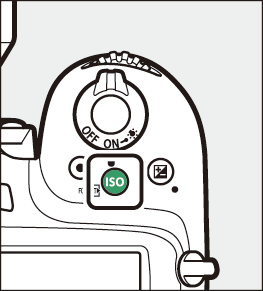

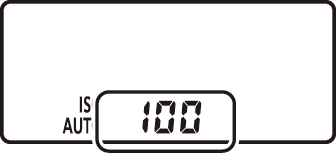

-
b and all EFCT modes other than j also offer an ISO sensitivity of X ([]). When X is selected, the camera adjusts ISO sensitivity automatically.
-
By default, changes are made in increments of 1/3 EV. The size of the increments can be changed using Custom Setting b1 [].
ISO sensitivity can also be adjusted using the [] item in the photo shooting menu.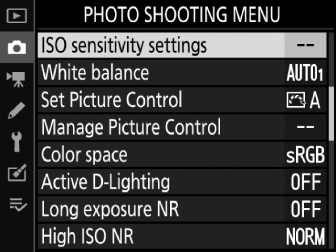
The higher the ISO sensitivity, the less light needed to make an exposure, allowing pictures to be taken when lighting is poor and helping prevent blur when the subject is in motion. Note, however, that the higher the sensitivity, the more likely the image is to be affected by “noise” in the form of randomly-spaced bright pixels, fog, or lines.
-
“Noise” can be reduced by enabling high ISO noise reduction. High ISO noise reduction can be enabled using the [] items in the photo and movie shooting menus.
A setting of [] corresponds to an ISO sensitivity approximately 0.3 EV higher than ISO 51200 (ISO 64000) and [] to an ISO sensitivity approximately 2 EV higher (ISO 204800). Note that pictures taken at these settings are particularly prone to “noise” in the form of randomly-spaced bright pixels, fog, or lines.
The settings [] through [] correspond to ISO sensitivities 0.3–1 EV below ISO 100 (ISO 80–50 equivalent). Use for larger apertures or slower shutter speeds when lighting is bright. Highlights may be overexposed. In most cases, ISO sensitivities of ISO [] or above are recommended.
Auto ISO Sensitivity Control
Auto ISO sensitivity control automatically adjusts ISO sensitivity if optimal exposure cannot be achieved at the value selected by the user in P, S, A, and M modes.
Enabling Auto ISO Sensitivity Control
-
Select [] in the photo shooting menu, highlight [] and press 2.
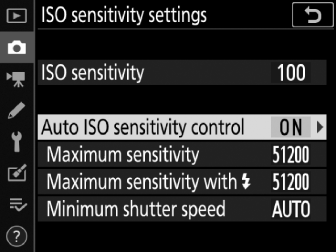
-
Select [].
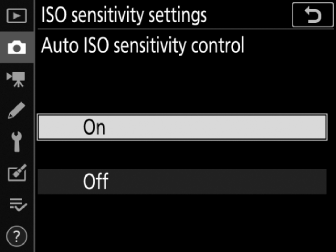
-
Highlight [] and press J to enable auto ISO sensitivity control. If a flash is used, ISO sensitivity will be adjusted appropriately.
-
If [] is selected, sensitivity will remain fixed at the value selected by the user.
-
-
Adjust settings.
-
Adjust auto ISO sensitivity control settings.
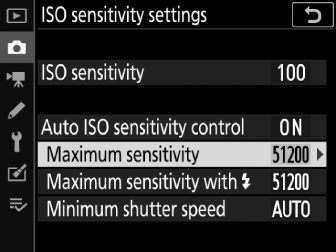
Option
Description
[]
To prevent ISO sensitivity being raised too high, you can select an upper limit for ISO sensitivity control; choose from values of from ISO 200 to Hi 2. The minimum value that will be selected using auto ISO sensitivity control is ISO 100.
[]
Choose the maximum ISO sensitivity for flash photography; options range from ISO 200 to Hi 2. Selecting [] sets the maximum ISO sensitivity for flash photography to the value currently selected for [].
[]
In modes P and A, auto ISO sensitivity control only takes effect if shutter speed needed for optimal exposure would fall below this value; choose from settings of 1/4000 s to 30 s. If [] is selected, the camera will choose the minimum shutter speed based on lens focal length (CPU lenses only). For example, the camera will automatically choose faster minimum shutter speeds to prevent blur caused by camera shake when a long lens is attached.
-
To view auto shutter-speed selection options, highlight [] and press 2. Auto shutter-speed selection can be fine-tuned by choosing faster or slower minimums. Faster settings can be used to reduce blur when photographing fast-moving subjects.
-
Shutter speeds may drop below the selected minimum if optimal exposure cannot be achieved at the ISO sensitivity chosen for [].
-
-
Press J to save changes.
-
When [] is selected for [], ISO AUTO indicators will appear in the control panel and viewfinder. When these indicators are lit (not flashing), pictures will be taken at the sensitivity selected for []. When sensitivity is altered from the value selected by the user, the ISO AUTO indicators will flash and the altered value will be shown in the displays.
|
|
|
-
If value currently selected for [] is higher than that chosen for [], the value chosen for [] will serve as the upper limit for auto ISO sensitivity control.
-
During flash photography, shutter speed is limited to the range defined by the values selected for Custom Settings e1 [] and e2 []. If the value selected for [] is not in this range, the value selected for Custom Setting e2 [] becomes the effective minimum shutter speed.
-
If a non-CPU lens is used without lens data, the minimum shutter speed will be fixed at 1/30 s.
-
If an optional flash unit is attached, ISO sensitivity may be raised automatically when auto ISO sensitivity control is used in combination with slow sync flash modes, possibly preventing the camera from selecting slow shutter speeds ( Using an On-Camera Flash , Flash Modes ).
You can turn [] on or off by pressing the S (Q) button and rotating the sub-command dial ( Enabling Auto ISO Sensitivity Control ).

